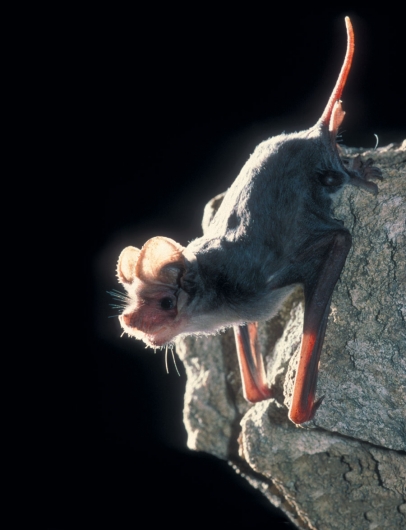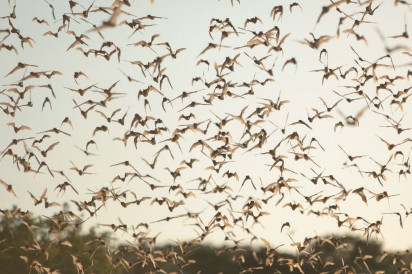Behold Our Beneficial Bat
Bats have a bad rap: seen as scary and associated with spooky tales. We do well to remember the bat is really a little wonder of nature—and, as insect-eater and pollinator, quite beneficial too!
Standing beneath the Waugh Street Bridge at dusk allows you to be a spectacular witness of nature. This is when over 250,000 Mexican free-tailed bats, Tadarida brasiliensis, leave the warmth of the bridge and fly out for dinner. Viewed from atop the bridge or from the grassy knolls or viewing platforms, it is a sight to behold. But for the most awe-inspiring view of these amazing creatures of the night, head for the walkway under the bridge.
The sun’s rays have yet to depart when the first bats begin to emerge. Whirling beneath the bridge in dizzying circles a few more bats join the group. We survey the concrete pillars and two-inch gaps between slabs to discover their origin. Above our heads, a vibrating black mass creeps along the engineered cracks spanning the bridge. Indistinguishable, the dark globs drip down as long bony-fingered wings stretch beyond the furry frenzy until the tiny mammals break free and fall into flight.
Another fantastic view is from the Buffalo Bayou Partnership’s pontoon tour boat, Spirit of the Bayou. Captain Robby Robinson, BBP’s field operations manager, and crew narrate the one-and-a-half hour cruise educating about the bayou and the bats. Most Mexican free-tailed bat colonies in Texas migrate south for winter, but the Waugh Bridge has bats roosting in its crevices year-round.
Mating begins in early spring and pups are born in June. During the summer months the colony doubles in size. The pups are weaned from mother’s milk in about five to six weeks and are ready to learn to fly. At seven weeks, typically, pups are independent and able to eat and catch their own insects. Unfortunately, many of the pups do not survive to adulthood and the colony’s peak (between August and October) is estimated to be 300,000.
Diana Foss, urban wildlife biologist at Texas Parks & Wildlife Department (TPWD), explains that Mexican free-tailed bats are renowned for their flying abilities, and are estimated to be able to fly at 60 miles per hour (with a tail wind).
“From our observations at Waugh, our bats tend to fly into prevailing winds to gain altitude and head out to catch insects. They leave as a group, probably a ‘safety in numbers’ thing, to avoid aerial predators such as hawks, owls and falcons. Eventually, they disperse over a wider area to catch insects.”
Collectively the Waugh Bridge colony eats an estimated two to three tons of insects a night, with moths as the primary food source. The bats will also eat beetles, wasps, flies, stink bugs, squash bugs and cicadas—all agricultural pests, thus benefiting local farms as a natural source of pest management. Foss points out, “Houston is fairly ‘buggy’ with all our bayous, so there are usually plenty of insects for bats to each night.”
An estimated 30 species of bats live in Texas. The City of Houston is building new bridges to encourage bat populations, said Captain Robinson.
Another species of bat living in Texas is the long-nosed bat, Leptonycteris nivalis. Nectar and pollen are the main food sources for longnosed bats. Their incredible sense of smell helps locate desert cactus flowers as food. One particular food source is agave: Bats are the primary pollinators of the tequila plant. As their long tongues protrude to drink generous amounts of nectar, their fur becomes covered in pollen. During nightly feeding, pollen is carried to new flowers, assisting in fertilization. Due to habitat loss, the long-nosed bat numbers are declining. It is believed that agave cannot exist without bats.
Next time you sip tequila, raise your drink in honor of these spectacular nocturnal creatures.







